AMD A10-5700 Trinity Desktop APU - Going Back for Seconds
The AMD A10-5700 Trinity desktop APU is a 'quad-core' processor that's just a shade slower than the top tier AMD A10-5800K chip. With a rated clock speed of 3.8GHz, a Turbo Speed of up to 4.0GHz, a 65W TDP rating, it features a slightly slower Radeon HD 7660D graphics core. Would this multiplier-locked APU still present compelling value? We check it out!
By Wong Chung Wee -
AMD A10-5700 - Going Back for Seconds
In October this year, we witnessed the official launch of AMD's desktop Trinity APU with its flagship AMD A10-5800K. Following this top-end APU like a loyal and trustworthy wingman, the A10-5700 is positioned as more power-efficient alternative to the A10-5800K. The former is rated at 65W TDP and in order to balance its performance with a lower power envelope, the A10-5700 is rated at 3.4GHz for its base clock speed (as opposed to 3.8GHz on the 5800K model). Its Turbo CPU clock is a respectable 4.0GHz (down from 4.2GHz on the speedier variant). However, the attractive aspect about this lower-powered APU is that it still features the same Radeon HD 7660D graphics core from more powerful counterpart, albeit with a lower GPU clock speed at 760MHz versus 800MHz.
With such a slight discount in its core speeds (both on the CPU and GPU portions), we do have the initial expectations that the A10-5700 shouldn't lag too far behind the A10-5800K. Hence, we decided to dip back into the buffet spread of Trinity APUs by going back for seconds with the A10-5700 on our plates. Priced at S$136, is it also a worthy buy? That's what we intend to find out as we compare it against the recently reviewed A10-5800K APU that has a suggested standalone price of S$169.

Like most of the other Trinity APUs, the A10-5700 comes in a compact retail package, together with a CPU cooler and a sticker that boasts of the APU's Trinity lineage.
Model | Radeon
GPU | TDP | CPU
Cores | CPUClock
(Base / Turbo) | L2 Cache | AMD Turbo
Core 3.0 | Radeon Cores | GPUClock
(base) | DDR3 Memory Support |
A10-5800K | HD 7660D | 100W | 4 | 3.8GHz / 4.2GHz | 4MB | Yes | 384 | 800MHz | up to 1866MHz |
A10-5700 | HD 7660D | 65W | 4 | 3.4GHz / 4.0GHz | 4MB | Yes | 384 | 760MHz | up to 1866MHz |
A8-5600K | HD 7560D | 100W | 4 | 3.6GHz / 3.9GHz | 4MB | Yes | 256 | 760MHz | up to 1866MHz |
A8-5500 | HD 7560D | 65W | 4 | 3.2GHz / 3.7GHz | 4MB | Yes | 256 | 760MHz | up to 1866MHz |
A6-5400K | HD 7540D | 65W | 2 | 3.6GHz / 3.8GHz | 1MB | Yes | 192 | 760MHz | up to 1866MHz |
A4-5300 | HD 7480D | 65W | 2 | 3.4GHz / 3.6GHz | 1MB | Yes | 128 | 723MHz | up to 1600MHz |
Test Setup
The AMD A10-5700 was tested with the MSI FM- A85XA-G65 motherboard as our initially used ASUS F2A85-M Pro motherboard developed technical issues. Otherwise, the test parameters used and all other comparisons are identical to our test setup documentation outlined in our review of the AMD A10-5800K APU. Considering its price point and specs, we'll closely monitor its results against the AMD A10-5800K APU and the Intel Core i3-3220 CPU.
SYSmark 2007 Results
In this platform-intensive benchmark, our AMD A10-5700 was found to be trailing about 7.7% behind the top-end A10-5800K. This sounds in-line with its 11% difference in raw clock speed. Despite this, the A10-5700 still came out to be 12% speedier than the previous generation Llano APU.
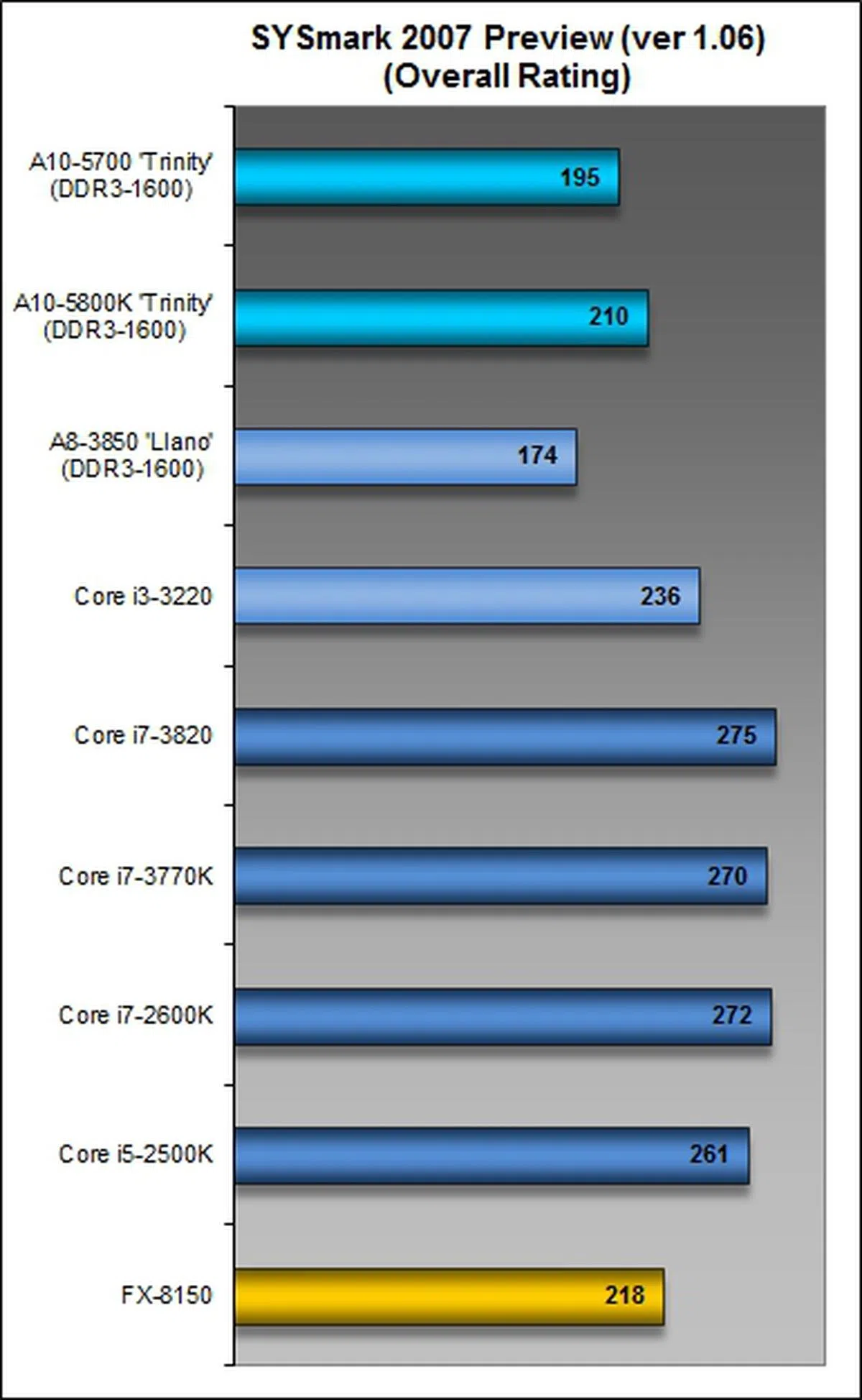 | 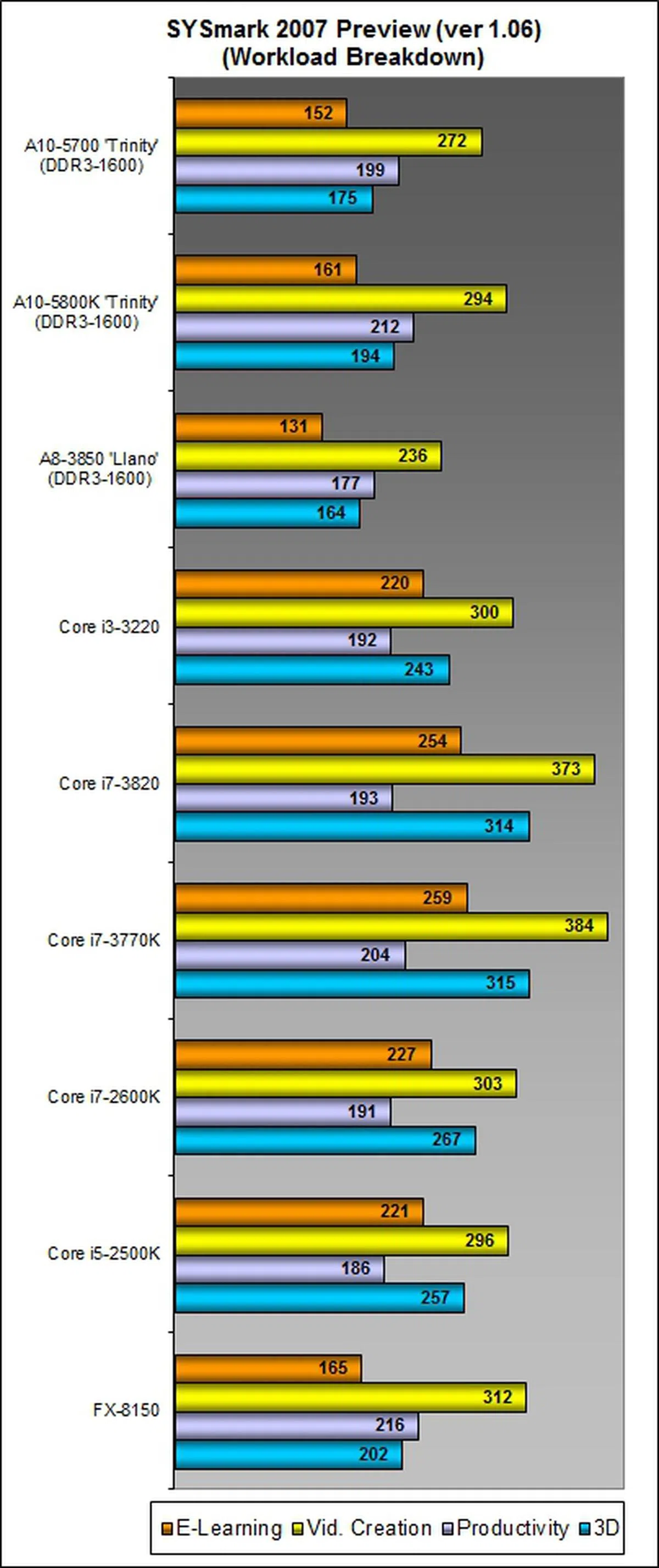 |
Lightwave 3D 9.0 Results
Performance on Lightwave 3D was in-line with what we had witnessed earlier in the SYSmark 2007 benchmark as the A10-5700 only managed to outclass the previous generation Llano APU - barely. In some test situations like the 4- or 8-thread runs, the A10-5700 actually ranks in slower than the best Llano-based desktop APU.
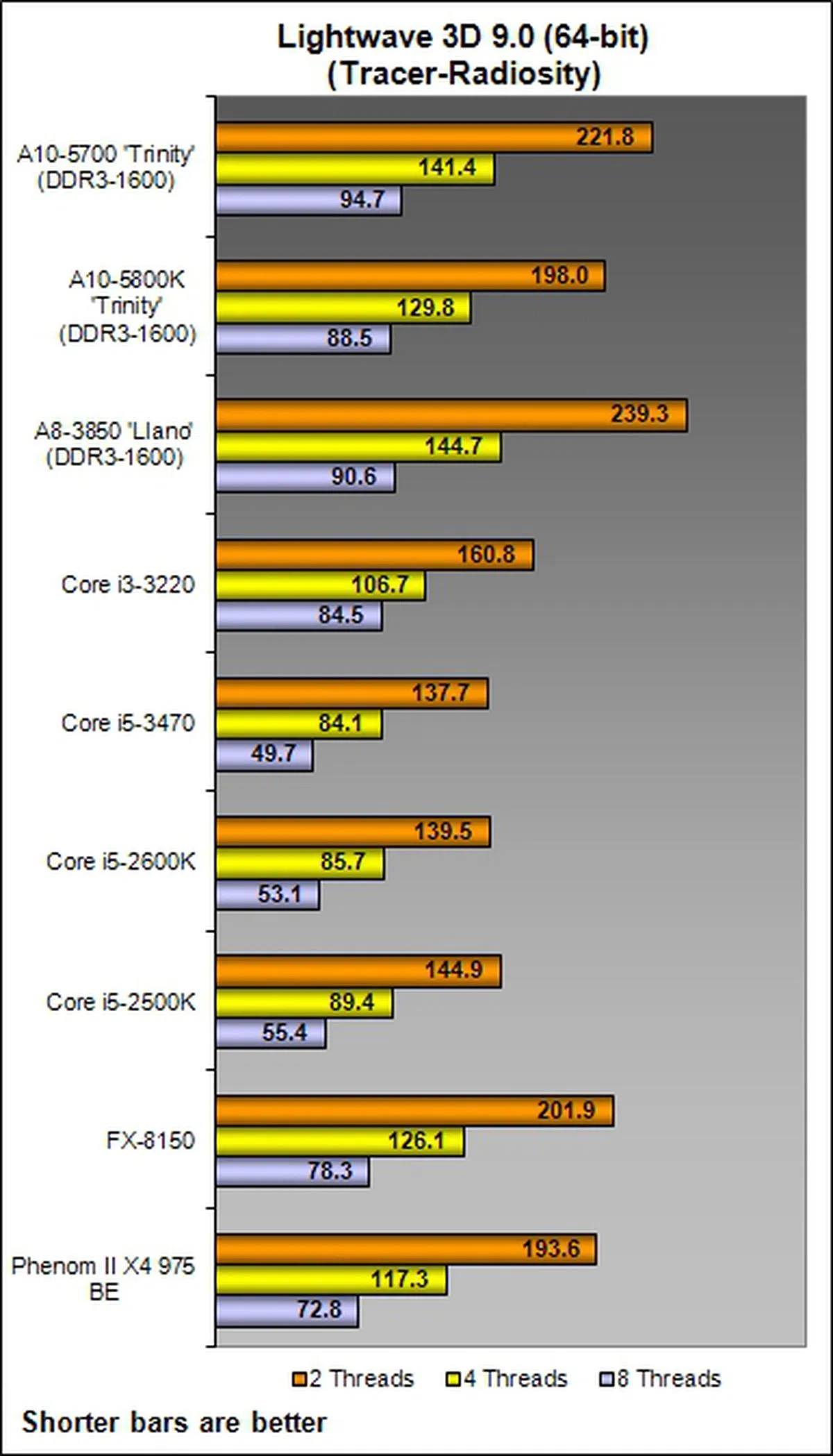 |  |
Futuremark PCMark Vantage Results
To measure the system's performance across a wide variety of common tasks such as photo viewing, photo editing, video, music and productivity, we made use of our trusty PCMark Vantage benchmark to gauge the performance of a processor. For the benchmark's overall score, the AMD A10-5700 trailed behind the A10-5800K by a margin of 8%; as a whole, the Trinity APUs performed at a higher par than their main competitor, the Intel Core i3-3220, by pulling ahead with margins in the range of 3.2- to 11.5%. An anomaly is observed in the Memories Suite results, as the A10-5700 pulled ahead of the A10-5800K by a margin of about 4%.

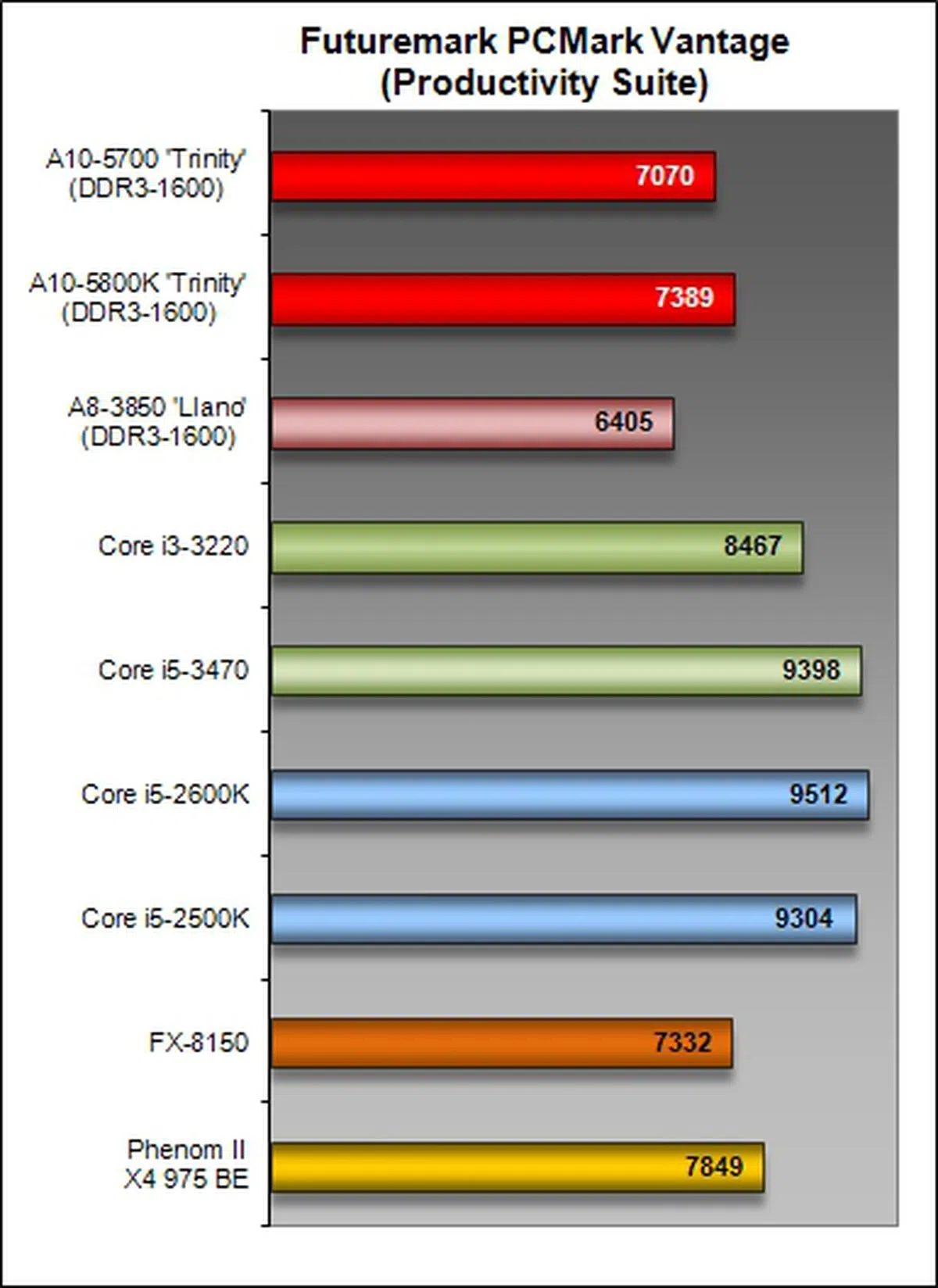 | 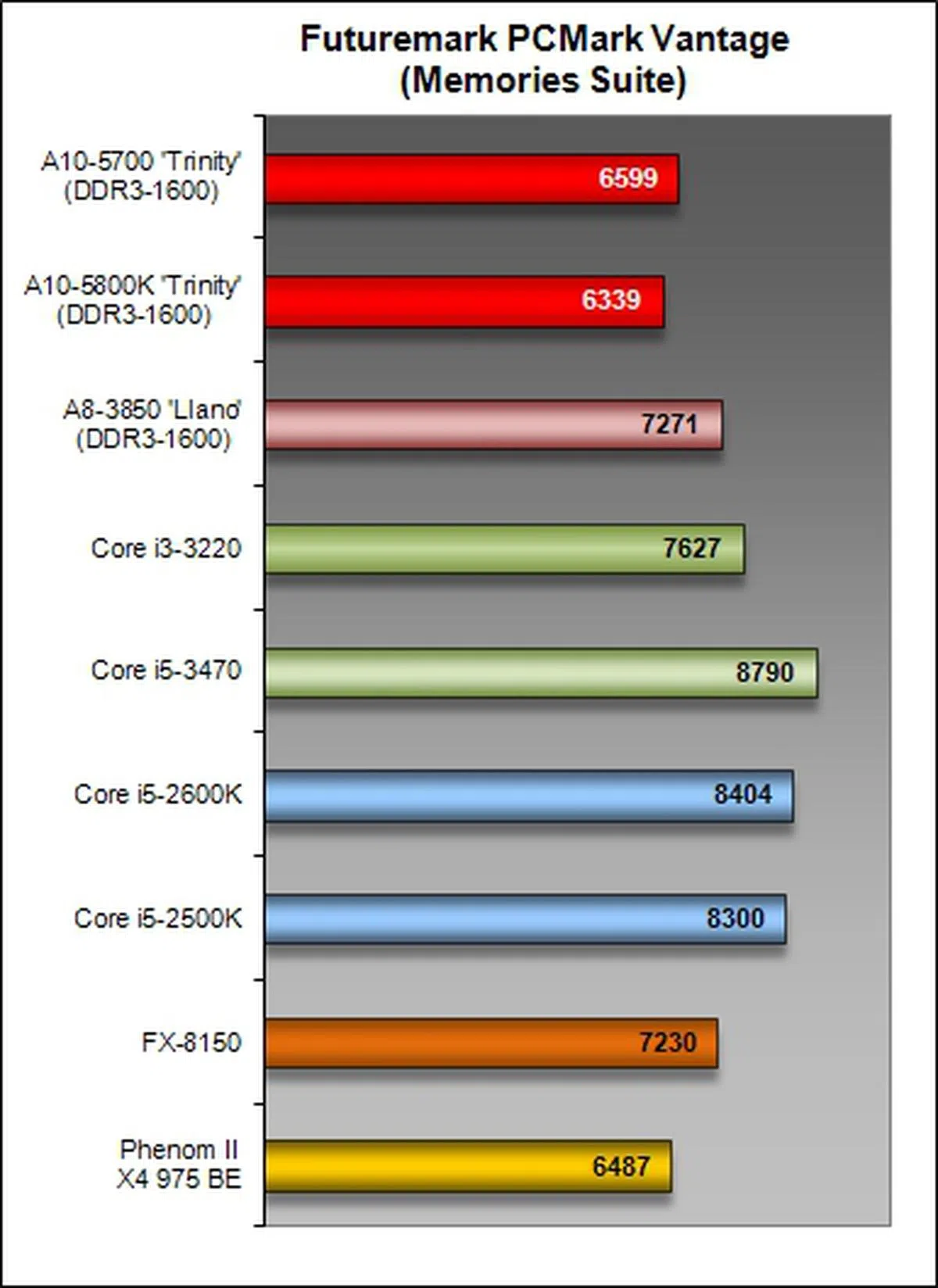 |
Cinebench 11.5 Results
Just as we've pointed out in our review of the A10-5800K, the A10-5700 too isn't a true 'quad-core' processor. With only dual floating-point units available in the APU, its performance is strictly comparable in the dual-core processor world. As such, the A10-5700 came up to be even slower than the A10-5800K and trailed behind the previous generation A8-3850 APU by a margin of 14%. Seems like the floating point performance is really not up to scratch on the Piledriver core.

Handbrake 0.9.4 Results
On Handbrake, the performance turned in by the A10-5700 was in line with expectation as with the anemic sub-par achievement by the top-end A10-5800K, it came as no surprise that the former took an additional 34 seconds to complete encoding our test video file. Both the Trinity APUs lost to their previous generation counterpart, the A8-3850 APU while outperforming the Intel Core i3-3220.
Take note though, AMD has mentioned that the latest revision of Handbrake will come with OpenCL acceleration and that should help it take advantage of the built-in GPU to accelerate such encoding tasks. We'll run another story soon to showcase the differences brought about from using the latest optimized applications.

3ds Max 8 (SP2) Results
The Trinity APUs were outclassed in terms of their CPU compute prowess for this benchmark. Sadly, even the previous generation Llano A8-3850 APU put in better performance than the newer APUs.
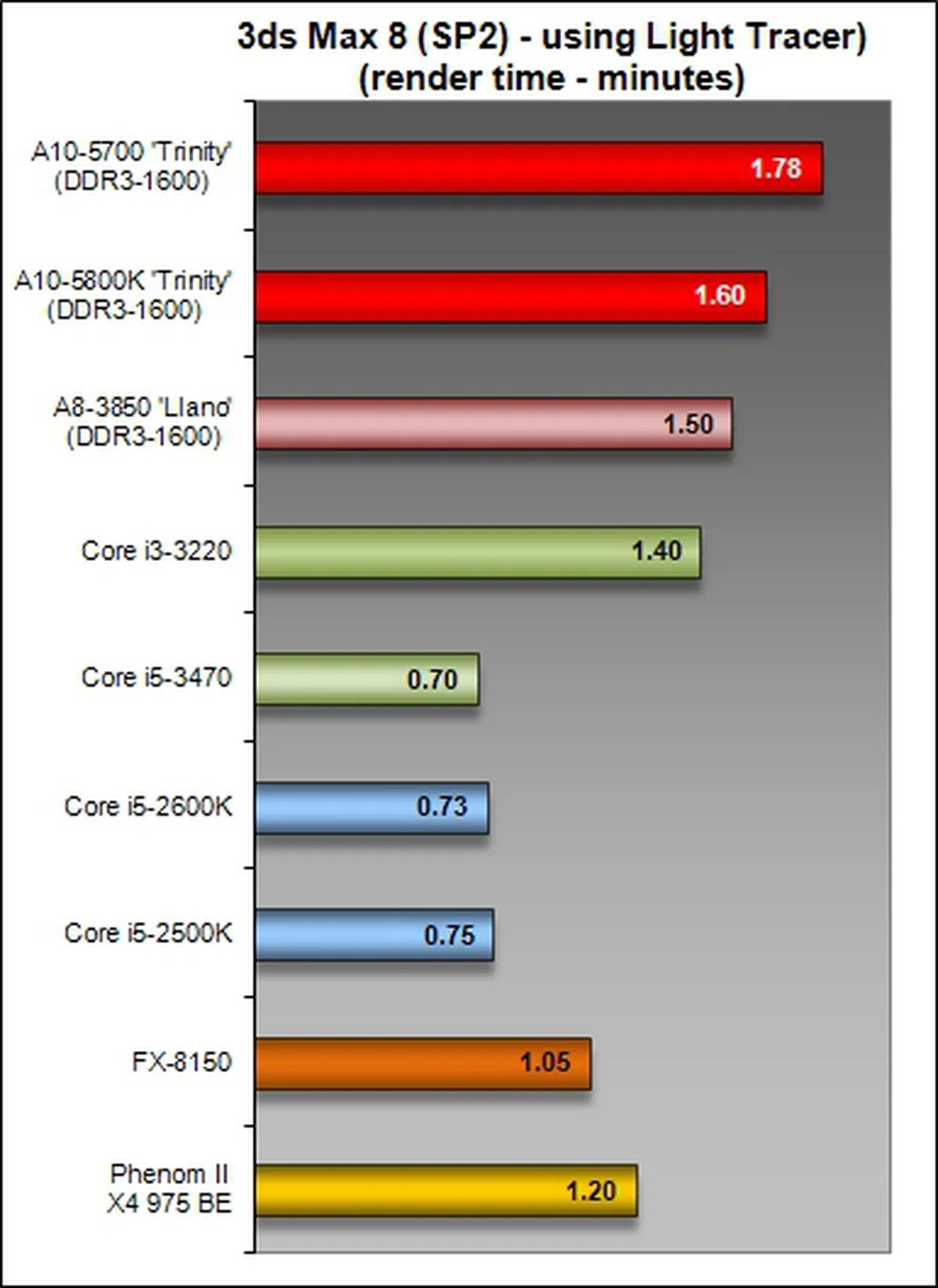 | 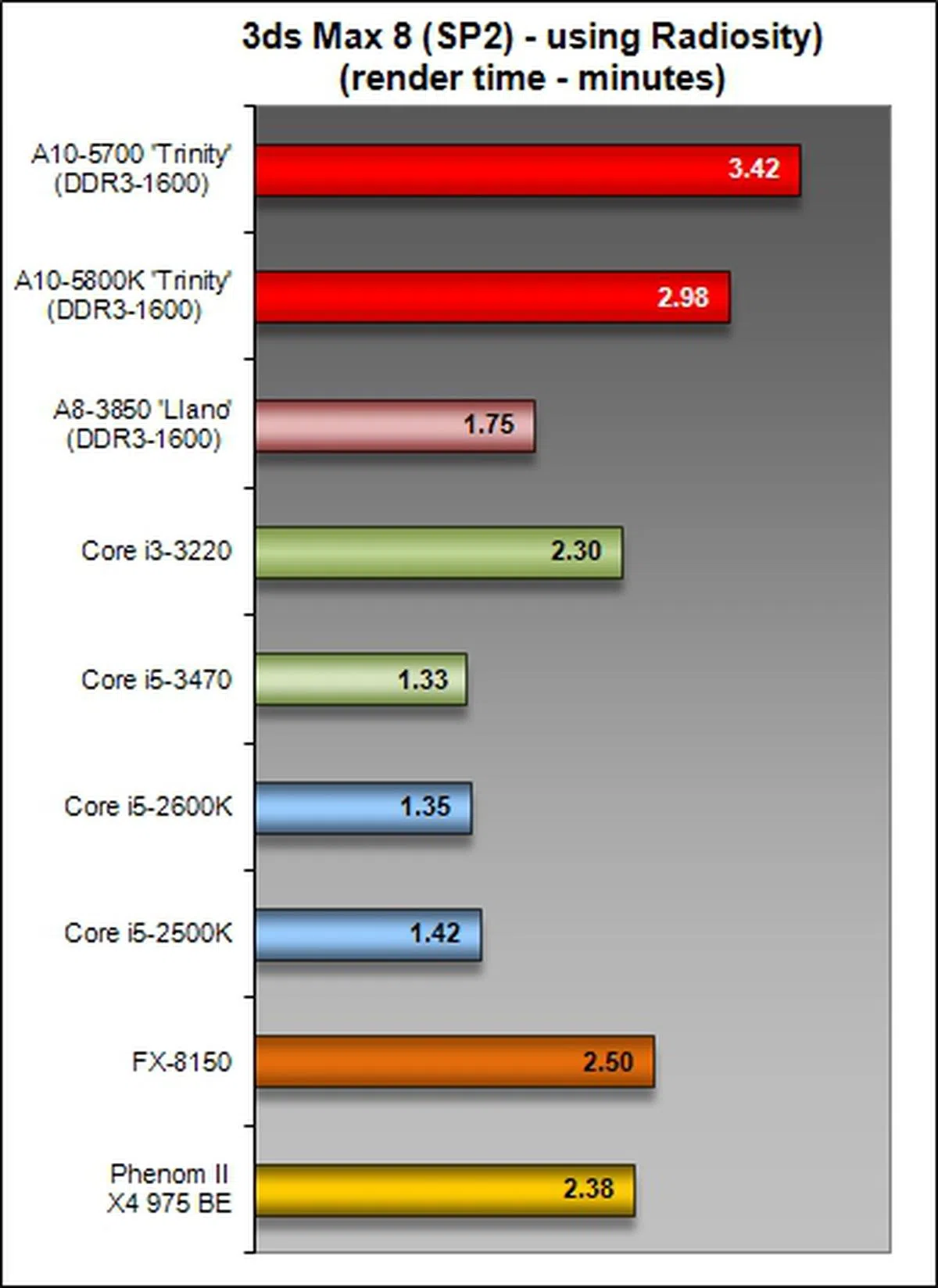 |
Futuremark 3DMark Vantage Results
Note that in this test, we've continued using the same discrete graphics card to ascertain the influence of the platform in gaming related matters. We've another page later that will compare the APU's integrated graphics performance. Overall, the reduced clock speeds on the A10-5700 didn't seem to affect the overall 3DMark results for mainstream gaming, though the CPU portion of the test certainly reflected the change. Will other games be affected or show indifference? We detail that on the next page.
 | 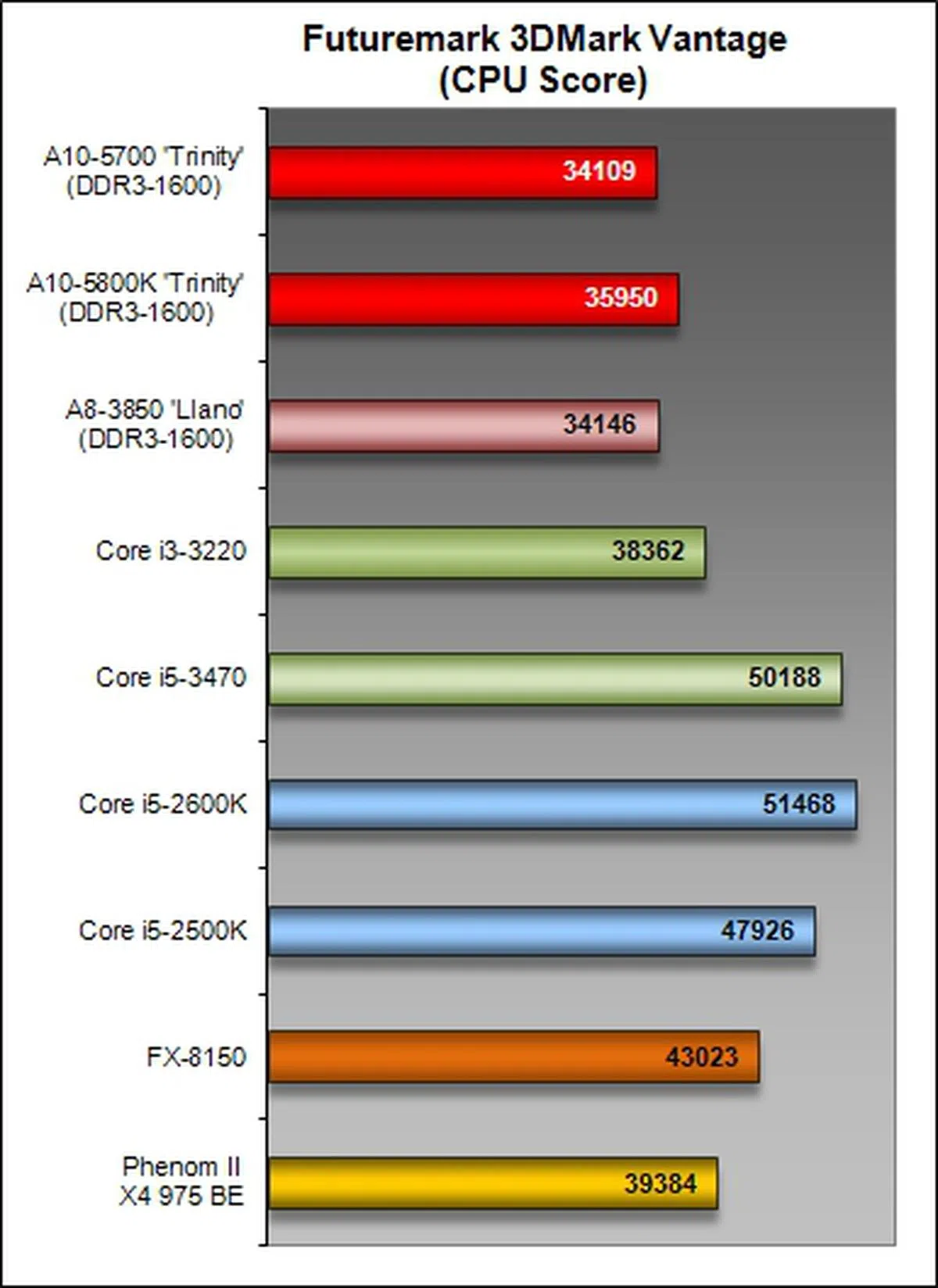 |
Far Cry 2 Results
Continuing the testing on the same discrete graphics card to check the influence of the platform in actual games, we found the the A10-5700 to outperform the Llano A8-3850 by a small margin of about 3%. The Intel platform fared much better on this benchmark, thus showing this game's reliance on the platform's throughput for better results despite using the same GPU.

Battlefield Bad Company 2 Results
On the other hand, this DirectX 11-supported gaming benchmark switched tables somewhat and gave the AMD APUs a lead in its competitive class of processors. The A10-5700 turned in a better performance against the Llano and Intel Core i3-3220 processors.

Integrated and Dual Graphics Performance
Although the AMD A10-5700 APU still boasts of the same Radeon HD 7660D graphics core as the A10-5800K, the former's graphics engine operates at a slower 760MHz clock speed, versus the 800MHz GPU clock of the A10-5800K. It will be interesting to see how this affects actual gaming performance. We also proceeded to ascertain how well AMD Dual Graphics technology worked when we pair the A10-5700K with a Radeon HD 6670 discrete graphics card. For this part of our benchmarking, we also turned off the AMD Dual Graphics technology, leaving our discrete GPU in the form of the Sapphire Radeon HD 6670 graphics card to churn out graphics performance on the same test bed. This will give us some insights to improvements made from enabling Dual Graphics Technology.
Futuremark 3DMark Vantage
3DMark scores are looking pretty rosy for even the integrated graphics performance on the A10-5700 as it's just 4.7% off from its A10-5800K brother. This means, it still delivers firepower that can almost match a GeForce GT 440 discrete graphics card and is notably speedier than any other processor's integrated graphics performance.
With the AMD Dual Graphics technology turned on, the graphics performance of the A10-5700 was boosted by about 17% as compared to the score achieved when AMD Dual Technology was turned off, i.e., the APU was running off the Sapphire Radeon HD 6670 discrete graphics card without the support of Dual Graphics. Overall boost from this pairing is slightly over 62% against just the Trinity GPU's own capability.

Far Cry 2
Now with a real DX10 game, we think the A10-5700 does a marvelous job in maintaining near identical integrated graphics performance to the A10-5800K, despite the clock speed differential both on the CPU and GPU front. Intel's IGP is far behind no matter it's a Core i3 or a Core i7 part. Oddly, the A10-5700 had wore performance with AMD Dual Graphics enabled than it was disabled. But in any case, the top-end A10-5800K hardly benefited either.

Battlefield: Bad Company 2
Once more, we find the A10-5700 raking in excellent integrated graphics performance, while smoking the competition. The reduced clock speeds has hardly degraded the A10-5700's gaming performance against the A10-5800K.
In line with our previous test experience with the A10-5800K APU, the Dual Graphics technology showed its mettle when we cranked up the gaming settings to "High" as seen in the second attached graph. Although with a slightly slower 760GHz GPU clock, the AMD A10-5700 still managed to churn out frame rates above 30fps and with the benefit of Dual Graphics technology, its integrated graphics performance was boasted by a margin of slightly over 89%. Do note that the Intel HD Graphics 2500 in the form of the Intel Core i3-3220 failed to execute this gaming benchmark even at the medium game quality settings.


CPU Utilization on Media Decoding
The A10-5700 turned in rather impressive performance for this test and actually fared better than the A10-5800K, rivaling discrete class GPUs.

Power Consumption
On this test, we're back to utilizing a discrete graphics card to control all possible variables. Although the A10-5700 is rated at 65W TDP, its idle power draw registered higher at 83W than that of the A10-5800K. Do note that the A10-5700 was tested on a different board from the A10-5800K due to a technical glitch. At load testing, we saw less influence of the motherboard and actually noticed slightly better power consumption figures that are better in-line with our expectations.
 |  |

Overclocking
As creatures of habit, we eschew the AMD OverDrive software utility and used the UEFI BIOS utility of our MSI FM2-A85XA-G65 motherboard to overclock the A10-5700. We could only approach this exercise by tweaking the board's CPU Base Frequency from its default value of 100MHz to higher levels. This is due to locked CPU multiplier of the A10-5700 APU. We also had to turn off the AMD Turbo Core 3.0 feature of the APU (for MSI's UEFI utility, it corresponds to the AMD Turbo Core Technology setting) as well as the C6 Mode function.

We managed to obtain a stable overclocked state of the APU by keeping its CPU Ratio to 34, while pushing its Base Frequency to 112MHz. Hence, in this case, its overclocked frequency was approximately 3.8GHz. At this clock rate, that should rival the AMD A10-5800K model (without Turbo Core activated).
For Cinebench 11.5, our overclocking efforts translated to a paltry gain of about 7%. For its CPU Score of the 3DMark Vantage benchmark, the gain was less, with an approximate 2.7% improvement. For the Far Cry 2 scores, the overclocked A10-5700 APU did surprise us with a 14% gain in average frame rates. Hence, although the APU features a locked CPU multiplier, we do see some performance gains when it is paired with a board that is able to operate stably at higher CPU base frequency settings.

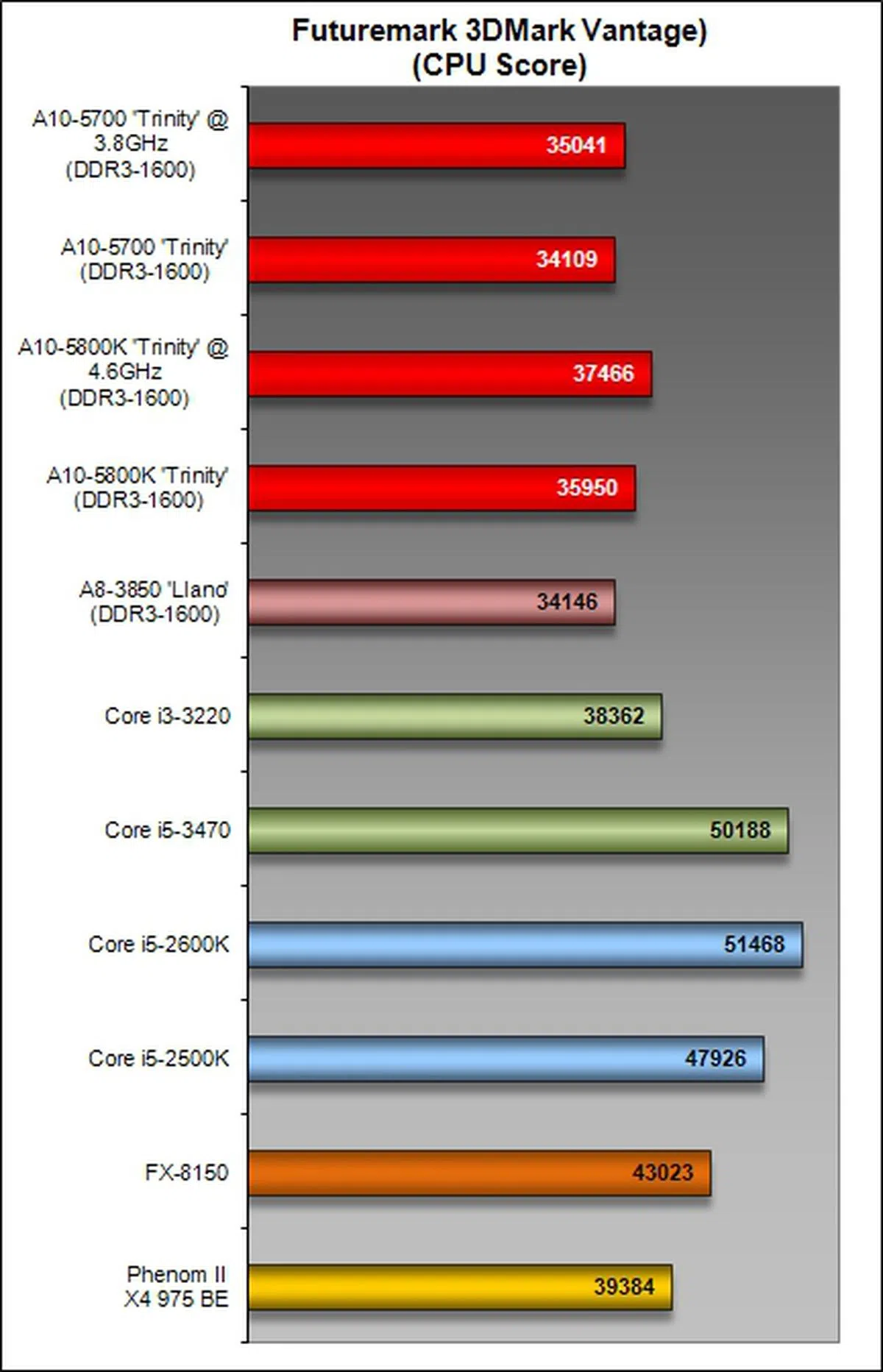 | 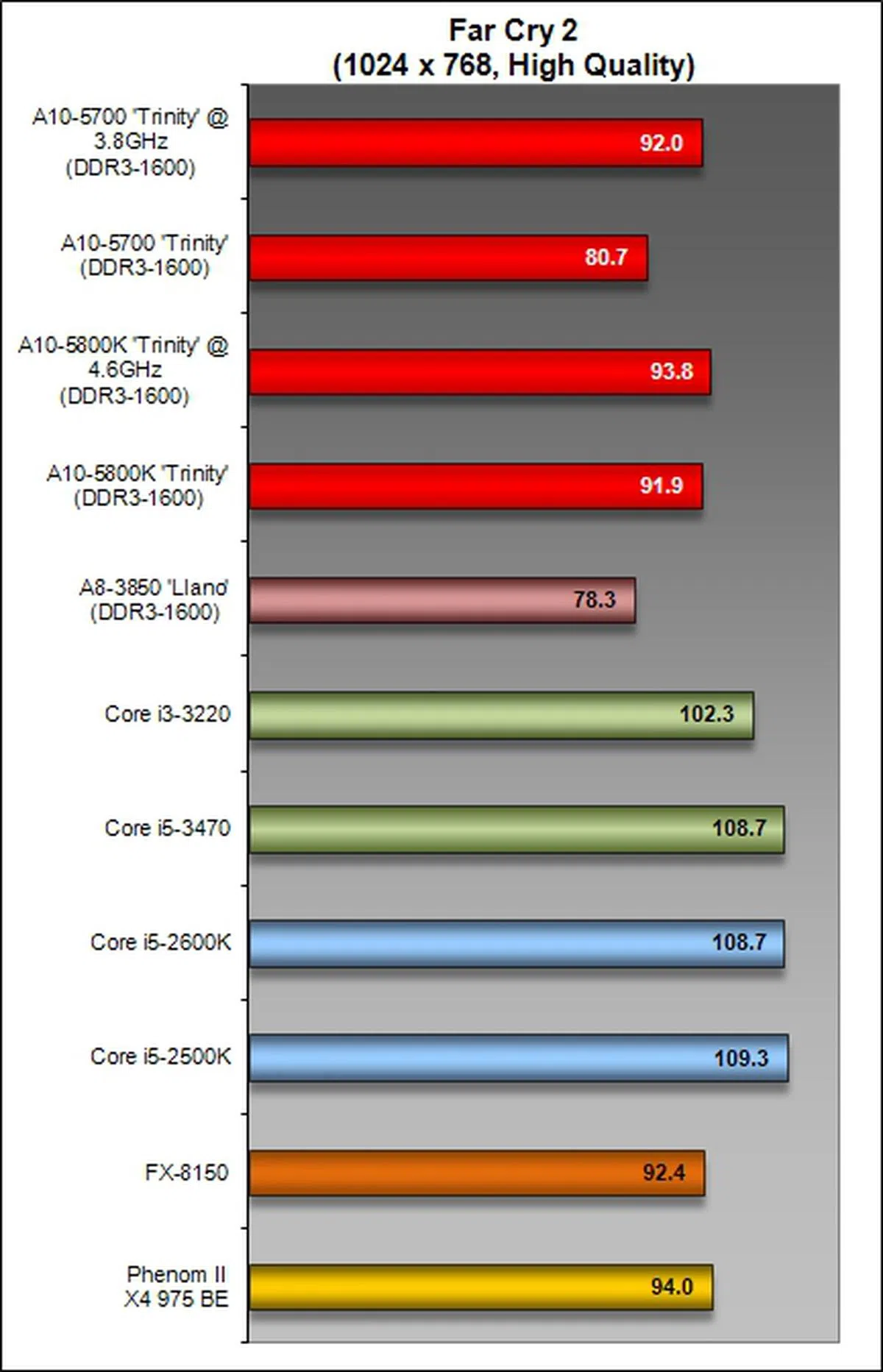 |
Conclusion
Despite its reduced 65W TDP power envelope, the A10-5700 carries the same Radeon HD 7660D graphics core that runs at a slightly lower GPU clock of 760MHz. Despite the processor's lower operating frequencies for both the CPU and GPU portions of the APU, we've witnessed that its integrated graphics performance is still in the same class as the A10-5800K and outpacing all of the competition by a large degree. In essence, the APU extends the appeal of the A10 series of desktop APUs to the same target audience of that of its unlocked brethren, the A10-5800K.

The AMD A10-5700 boasts of a pair of dual-core Piledriver units that run at 3.4GHz; however, due to its power-saving TDP rating of only 65W, its AMD Turbo Core boosted clock speed of up to 4.0GHz meant visibly lower performance levels than the A10-5800K in some of the more compute intensive tests. Fortunately, integrated performance is still rock solid.
Overall, the A10-5700 is a decent mainstream 'quad-core' APU, but without flexible overclocking capabilities, it's unlikely to appeal to tweakers who seek to eke out any possible performance gains out of a processor. When compared against the A10-5800K, its performance is in-line with our initial expectations due to its discounted CPU base clock speed as well as its stated Turbo clock speed of up to 4GHz. As a bonus, it did manage to pull off some surprising wins over the higher-end unlocked APU during our Blu-ray playback CPU utilization test as well as for the Memories test suite in the PCMark Vantage benchmark.
With its reduced price point of S$136, it translates to a discount of about 25% off the A10-5800K. In a nutshell, the AMD A10-5700 is ideal for those who aren't thinking of overclocking and yet would like to obtain performance levels somewhat similar to the A10-5800K - especially with regards to integrated graphics performance. At such a price point, this means a bundle price of an appropriate board and the A10-5700 can be as low as just S$250. This makes it far more attractive than the Intel counterparts if raw processing throughput isn't really going to be missed. As we've seen, AMD is all out to improve the immediate experiential aspects of using a system for mainstream users and we think the AMD Trinity APU might just do the trick.
Our articles may contain affiliate links. If you buy through these links, we may earn a small commission.